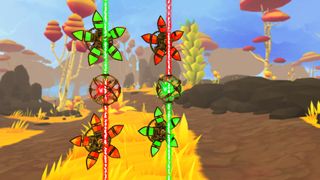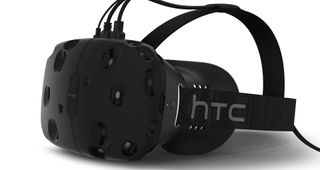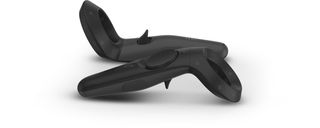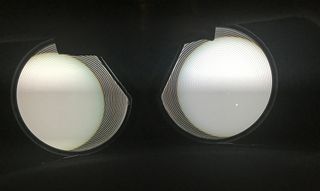Our Verdict
Despite some drawbacks with its hardware, the HTC Vive is an avenue to incredible VR experiences.
PC Gamer's got your back
Every time I slip on the HTC Vive, I think about the menacing, scarred presence of Tom Berenger in Platoon drawling, “You smoke this shit so’s to escape reality? I am reality.” The first thing I see, in SteamVR’s virtual nowhere, are the words “THIS IS REAL” hanging in the distance. As I play games, there are telltale signs that the worlds inside the Vive headset are not real. The density of the pixels bringing the images to life, the heavy plastic mounted to my head. The controllers in my hands. The occasional software glitch or loss of tracking. Even beyond that literal bit of text, though, the Vive boldly projects confidence that this is what VR should be like. That it will feel real, and that the future has finally arrived.
Vive deserves that confidence, because it’s correct. Right now, the HTC Vive is the best way to experience virtual reality. This is the VR you’ve been waiting for. The Vive is occasionally hindered by the growing pains of emergent hardware, but those issues don’t stop it from enabling new ways of playing and being immersed in games. After a week using the Vive, I’m more excited than ever about the future of VR on the PC. But let’s start with the present.
Preparing to Vive
The Vive differentiates itself from the Oculus and other VR systems presently available with two features: room-scale games and a pair of motion tracked controllers. The Vive hardware itself works just fine sitting down and using a gamepad, but its two laser-emitting Lighthouse base stations let you walk around in a space of approximately 4x3 meters (the minimum for room scale is 2x1.5 meters, and 4x3 won’t push the outer limits), if you have that much room for your VR setup. All this hardware leads to a far more complex setup process than the Oculus Rift. Both controllers come with their own micro USB charging cables and plugs, the two Lighthouse stations have their own power sources, the headset comes with a spare foam face rest, and there’s a cable breakout box to stop you from yanking over your PC if you accidentally step on the Vive’s cable.
After a week using the Vive, I’m more excited than ever about the future of VR.
Despite this giant pile of hardware, the Vive setup process is surprisingly easy. I didn’t encounter any issues running the setup software, which had me placing the controllers and headset on the ground to set its height, then drawing the boundary of my VR playspace using one of the controllers. The Lighthouse stations also come with ball bearing brackets for mounting. These worked well for our fairly open office space; we mounted one sensor to a beam and another to a reinforced cardboard box on a shelf. Setting up the Vive will be harder or easier for you depending on your available space (e.g., if you have some tall bookshelves, this should be a breeze, but you might need extension cables).
Plugging in the headset involves more cables—separate HDMI and USB cables from the breakout box to the PC, and cables from the headset to the breakout box—but it’s a fairly simple process, too. Properly angling the Lighthouse stations to see each other and cover your playspace is the biggest challenge (behind having enough room for the setup to begin with). And if you don’t have the space for this kind of setup at all, don’t worry—there’s an option in HTC’s software to configure the Vive for sitting and standing, but not room scale.

Unlike Oculus Home, a dashboard built from the ground up for VR, Valve has repurposed its Big Picture Mode interface for SteamVR. If you’re familiar with Steam (and what PC gamer isn’t, these days?) this makes it fairly easy to navigate your library and the store. I like being able to point at games with the Vive controller to select them and use the trackpad to scroll through my library, but I find using the trigger as a selector to be pretty finicky—I often have to click on an icon twice to properly select it, and some menu items are a bit small to easily point to.
While SteamVR can be fiddly, it also feels robust as an extension of a well established platform. It lets you bring up your desktop on a giant 'screen' in VR or boot up HTC’s own VR software, which is basically an empty environment at this point that you can use to...launch SteamVR (because Valve’s software isn’t exclusive to the Vive, it’s understandable the two would be separate). Yeah, it’s a bit messy, but it’s also very PC: the power to access what I need to on the desktop without taking off the headset is welcome. You never know when you’ll need to load up the web browser, kill a game process or mute a music player.

Into the Vive
SteamVR’s big innovation is the Chaperone system, which helps you avoid straying outside the boundaries of the playspace you established during the Vive setup process. It’s hard to overstate how important and effective the Chaperone system is. It is, absolutely, the reason room-scale VR works on the Vive. As you approach the boundaries you set, a light blue wireframe grid fades into view, showing where you need to stop before smacking into a wall or lamp or inflatable Godzilla (hey, it’s your house—I ain’t judgin’). I’ve only punched one thing while testing the Vive, and that’s because I was so absorbed that I reached beyond the boundaries to try to pick up an in-game object.

Taking the VR plunge yourself? We've got more for your to read.
How to prepare your room and PC for VR
Build a VR PC
Oculus Rift review
Hover Junkers review
Immersing myself in room-scale VR feels like it would be risky without the Chaperone system. The best games are totally engrossing, and sometimes I come out of the headset with no clue where I’m standing or which direction I’m facing. Many of the games available for the Vive right now are just demos or short experiences, but I’ve been taken aback by how many of these fully immerse my mind, wiping away my consciousness of the world outside the headset. There’s a reason Oculus started demoing VR standing up with the Crescent Bay prototype in 2014—the extra physicality, even without motion-tracked controls, transforms the experience.
The Vive’s cable is less of a hindrance than I expected, and I haven’t tripped on it yet. But I did step on it once and worried, for a second, that I was about to smash my whole VR setup. After quite a few hours using the Vive, I’ve mostly trained myself to be aware of where the cable is in relation to me, like a good guitar player on stage, and prevent it from tangling around my feet. But at least once per session it gets in the way, and I have to pause briefly to deal with it. Having to step gingerly around it is a bummer, but an unavoidable one until wireless latency and battery life leap forward.
The added physicality of standing transforms the VR experience.
My favorite Vive game so far, The Gallery: Call of Starseed, exemplifies the capabilities of the hardware and VR in general. The Gallery is a first attempt at a Myst-style adventure in VR, starting you on a mysterious island at night, with some simple environmental puzzles to solve and ambiance to spare. The key is that The Gallery’s environment is rich enough in detail, and high fidelity enough, to be quietly thrilling to poke around.
I love walking around my playspace to lean over tables or peer around the corners of a cave. And navigating the environment is handled elegantly with a teleportation system: press on the Vive controller’s trackpad, use your head to aim, and release to teleport to the marker. Rotating your thumb on the trackpad can reorient the direction you’re facing when you reappear. It’s not so different from the ‘click to teleport forward’ movement of Myst all those years ago, but being inside a 3D environment as you move is what really makes the experience.
The Gallery’s story starts ambiguously enough to put an emphasis on its environment, and that pays off in some some genuinely wonderful little moments, like firing a roman candle up a well shaft and watching it ricochet into the sky. Even without those touches, The Gallery is a testament to how immersive and physical a VR game can be. I naturally don’t want to clip through objects and instinctively reach out to pick up things as if they’re real. My brain is bought in.
As with the Oculus Rift, many of the launch games on the HTC Vive are demos and short experiences that make for compelling introductions to VR. The short film “The Rose and I” is incredibly simple, yet standing inside it and watching it play out is surprisingly moving (though at five minutes long, the $5 price feels steep). Another favorite is VR Baseball, a simple home run derby that takes some real skill to play. Swinging my arms, both hands on a single Vive controller, I was able to hit four home runs after a few rounds of trying. Then PC Gamer's US EIC Evan Lahti gave it a single try and knocked 16 out of the park. You can probably guess which one of us plays sports.

Though a novel experience, $10 again feels steep for a home run derby with mechanics and options this simple. Prices for many VR games on Steam feel high for what’s on offer, because many of these fit into a category of games that I’ll play for half an hour, then shelve until I need something simple to show to friends and family. But amid those simple experiences are a handful of games more exciting than almost anything I’ve played on the Oculus Rift, and all of them capitalize on the immersion of room-scale VR and motion controls to elevate what would be a been-there, done-that game on a monitor.
The serene Carpe Lucem incorporates your ability to walk around in 3D into the design of its puzzles, which involve directing beams of light with a variety of different tools. The first time I grabbed an ‘L’ pipe piece and pulled it from background to foreground in 3D and saw it rotate as it changed planes, I knew this was going to tap into a part of my brain I wasn’t used to using in puzzle games. I really want to play Blockout in VR.

Space Pirate Trainer takes the basics of an ‘80s arcade shooter and makes it an agile VR experience that sends me crouching to the floor and dodging incoming lasers in slow motion like I’m in The Matrix. Audioshield has me punching music to the beat instead of tapping buttons.
The satisfaction of these simple interactions in VR can have a profound effect. They help me forget the weight of the headset on my head, forget the resolution of the screen, and be truly immersed. I can’t stress this enough: this kind of interaction in VR does fundamentally different things to your brain than sitting and playing a game with a controller. In five years, VR will be useful for all kinds of things, and all kinds of games, but the ones that involve our entire bodies will captivate us the most. And the Vive is already on its way.

Form and function
The HTC Vive is not an elegant headset. While the Oculus Rift evolved through many prototypes into a slick, light headset built to woo the mass market, the Vive looks much the same as it did when it was unveiled in 2015: a big, unapologetic hunk of plastic. Heavy plastic. The Vive weighs noticeably more than the Oculus Rift (555 grams vs 470 grams), and feels more cumbersome for two reasons: it’s held on your head purely with elastic straps, unlike the Rift’s semi-firm rubber that gives it more rigid support, and it tends to rest some of its weight on the bridge of your nose. Much of the Rift’s weight is in those support arms, and that weight doesn’t actually press down on your head.
Designing a VR headset is an enormously complex task, but I believe HTC could have—and should have—shaved more weight off the Vive, and developed a sturdier strap system to better support its bulk.
The first two times I tried to adjust the Vive for my head, I was ready to throw the $800 headset straight into the garbage. Everything frustrated me. Compared to the Oculus, it’s very difficult to properly strap on by yourself. The Vive’s cable runs along its top strap, which makes that strap annoying to loosen or tighten when the headset is in place. I tried tightening the side straps to hold the headset firm, but found that its weight caused it to droop on my face just enough to blur my center of vision slightly. I was close, but clarity was maddeningly just out of reach. And the plastic clip on the left strap was rubbing painfully against the back of my ear as I moved. I felt pissed.
Eventually I got it right, and my opinion softened. With the Vive snug on my head now, I can slip it on with ease and have a clear field of view in a few seconds. The foam padding around the facerest is softer and more comfortable than the Rift’s, and it comes with a second foam pad for ‘narrow faces.’ I’m just speculating here, but the Rift’s firmer foam may actually help hold it in place better against your face—my biggest problem with adjusting the Vive was its weight causing it to sag downwards just slightly. The Vive’s softer foam may also wear down and compress after a few months, but for now, it’s the more comfortable material to have pressed against your face.
...for now, [Vive is] the more comfortable to have pressed against your face.
The physicality of using the Vive can often help distract me from its weight, but it does start to pinch my nose after 15 minutes or so. I often find myself pulling back on the straps like I’m recentering a baseball cap on my head. The fit will be different for everyone, and I recommend having someone help adjust it for you the first time you put it on.
While I don’t like the Vive resting on my nose, I love the plastic baffling HTC built around the nosepiece—it blocks out far more light than the bottom of the Rift headset, but still allows enough light in for me to hold my earbuds under my chin and check which one goes in which ear. It’s much easier to completely ignore the outside world staring at the Vive’s screen.
But why do I have to use my own earbuds or headphones? The Rift’s built-in earpieces are brilliant—they sound great, are loud enough to block most outside noise, and easily swing into position (and out of the way) on small plastic arms. The Vive, despite costing $200 more, has… a dangling 3.5mm audio plug. HTC’s pack-in earbuds are a cheap, poor excuse for audio. And good sound is hugely important to VR—realistic 3D audio helps our brain buy into what our eyes are seeing.
Using your own audio source adds another cable to the Vive mix and further complicates the process of putting on the headset. I’ve tangled myself in my earbud cables, and I’ve had to reach around blindly when the cable swings loose. Like the heavy plastic mounting, the lack of integrated audio makes the Vive feel less like a polished consumer product and more like very powerful, but still slightly awkward, hardware for a very niche audience.
By trying to pack as much as possible into the Vive, HTC made some compromises. But some of its power features are truly great. The front-facing camera lets you see what’s going on outside the headset without taking it off, and is a powerful addition to the Chaperone system. Games aren’t really using it yet, but we’ll see more from the camera in the future. And the headset has a lens-to-eye distance adjuster, activated by pulling out on the strap mounts on each side and rotating the circular mount points, that could be great for those who wear glasses. Everyone on staff who wears glasses has been able to wear them inside the Vive without a problem, with a more comfortable fit than in the Rift.

The controllers
The HTC Vive’s controllers make all the difference. Yes, standing and walking around in room-scale VR creates immersion, but your natural reaction, once you have that immersion, is to reach out and touch the world around you. We’re not all the way there yet, but the Vive’s controllers get us closer than we’ve ever been before. They’re shaped like wands with circular tracking arrays mounted on top, and they’re elegantly simple in terms of inputs. There’s one trigger, typically used to activate menus and ‘grab’ objects. A trackpad, much like the ones on the Steam Controller, sits on the front, and can be divided up into multiple buttons or inputs by developers. Small buttons above and below the trackpad serve as menu buttons, and a squeezable grip under your palm adds on extra input.
From the time I’ve spent with Oculus’s still-in-development Touch controller, it’s hard to say which will finally be the better VR input. The Touch controllers feel more natural—like making a fist instead of holding a wand—but the Vive controller’s trackpad is a nice forward-thinking bit of technology compared to the Oculus Touch’s more antiquated array of dual joysticks and four face buttons.
Your natural reaction, once you have that immersion, is to reach out and touch the world around you.
The one feature of the Vive controller I don’t especially like is the grip button—it’s easy to accidentally squeeze in the heat of the moment. In VR Baseball, the grip changes the vista outside the stadium, and on more than one occasion I changed it from a normal skybox to OUTER SPACE by squeezing a little too hard when I took a swing. Actually, that was pretty cool. But the point stands.
The rechargeable batteries in the controller have yet to run out on me, even after several hours of VR play per day and sometimes forgetting to charge them overnight. They’re rated for four hours of continuous play, but I think I’ve put that much time on them in a single day without charging and the batteries held out.
The accuracy of Valve’s positional tracking makes it a joy to use the Vive controllers, especially in games that let you interact with most objects in the environment, and I often find myself wanting to touch walls, tables, and other virtual objects. The controllers don’t entirely disappear in your hands, but they work well enough to facilitate basic interactions easily and intuitively, and that’s thrilling in VR.

The display
The HTC Vive uses the same 1080x1200 pixel displays as the Oculus Rift, which are high resolution enough to make the ‘screen door’ pixel density issue of past headsets mostly a thing of the past. The 90 Hz refresh rate, coupled with the Vive’s extremely accurate positional tracking, does a fantastic job of preventing VR motion sickness. If using the Vive makes you feel queasy, it’s almost certainly the fault of the games, not the hardware.
Also like the Oculus Rift, the Vive uses a pair of fresnel lenses to warp its 2D screens into a 3D field in front of you. That means the same issues that exist on the Oculus exist on the Vive. Here’s how I described it in my Oculus Rift review:
“The edges of bright in-game objects (and especially text) produce a distracting shimmering effect some people are calling ‘god rays’ or ‘light rays.’ Imagine looking up at the sun while standing underneath a tree, and seeing bright beams of light striking your eyes from around the edges of the leaves and branches. It’s a bit like that in VR, but every bit of white text you look at will have those shimmering rays streaking out toward your eyes. They move as you move your head and your perspective on the virtual world shifts, making anything bright you aren’t looking directly at blurry.
You can see a good example of the light ray effect in action here. I don’t think I even noticed this effect at first. I was just wowed by being in VR. VR is really cool! But now I find the light rays a constant distraction, a reminder that I am looking at a screen, and often a source of eye strain when trying to read shimmery text.”
While this effect is still present on the Vive, I don’t find it as pronounced or noticeable as I did on the Rift. Perhaps that’s due to subtle differences in the lenses, or the distraction of standing up in VR, or simply the things I’m looking at on the screen. But I’m less bothered by the light ‘blur’ on objects as I move my head from side to side.
I also love the Vive’s field of view compared to the Oculus. It’s not dramatically bigger, but it’s a different shape and feels like a larger window into VR with more vertical space. It’s a bit like peering through an old oval diving mask compared to the more horizontal Rift FOV.
The Vive’s screen is good enough for games and the SteamVR interface, but definitely too low-res for SteamVR’s ‘Desktop mode’ which lets you see your whole desktop. Things are too small to be easily legible and detail breaks up without a higher density pixel array. But there’s software to help with this, like Virtual Desktop. If the next generation of VR headsets are able to step up to 4K panels, they’ll be far better at representing text and UI outside of games.

Wrapping up
The weight, straps, and lack of integrated audio in the Vive are all disappointing elements of its hardware design. There are compromises here that you shouldn’t have to make for $800. These things, for me, cause the Vive to narrowly miss out on being an exceptional piece of hardware as a portal into the world of VR.
And yet the experiences it produces are exceptional. Developers aren’t yet forging incredible new ground in VR, designing genres that were never possible or thought of before, but the experiences they are already delivering feel fundamentally different. Being able to walk around, reach out and touch things, and believe you’re inside a 3D world—when I do those things on the Vive, it’s hard not to think that the future is here. A future that’s a little too heavy, a little ungainly, but bold and promising nonetheless.
When I played platformer JUMP, even with a controller, my stomach dropped each time I fell. Some part of my brain thought it was real. When I ask myself if I want to deal with the weight of the headset to play something as physically engaging as Space Pirate Trainer, even though it’s little more than an arcade shooting gallery, I say yes. When I draw in TiltBrush, I can’t help being excited about all the things kids and artists more skilled than I will create with it, that I’ll then be able to walk around in three dimensions. When I play awkward or basic launch games like A Legend of Luca, a fully room-scale RPG adventure, I see the potential of more complex games a year down the road.
The VR scene on SteamVR feels bustling, with more games coming every day and dozens already playable. Most still fit into that category of games that show the potential of VR, but won’t captivate your attention long-term. In the Vive, that feels okay, because the sheer act of being there is powerful by itself. Maybe it’s not reality, but it’s real enough.
Despite some drawbacks with its hardware, the HTC Vive is an avenue to incredible VR experiences.

Wes has been covering games and hardware for more than 10 years, first at tech sites like The Wirecutter and Tested before joining the PC Gamer team in 2014. Wes plays a little bit of everything, but he'll always jump at the chance to cover emulation and Japanese games.
When he's not obsessively optimizing and re-optimizing a tangle of conveyor belts in Satisfactory (it's really becoming a problem), he's probably playing a 20-year-old Final Fantasy or some opaque ASCII roguelike. With a focus on writing and editing features, he seeks out personal stories and in-depth histories from the corners of PC gaming and its niche communities. 50% pizza by volume (deep dish, to be specific).

